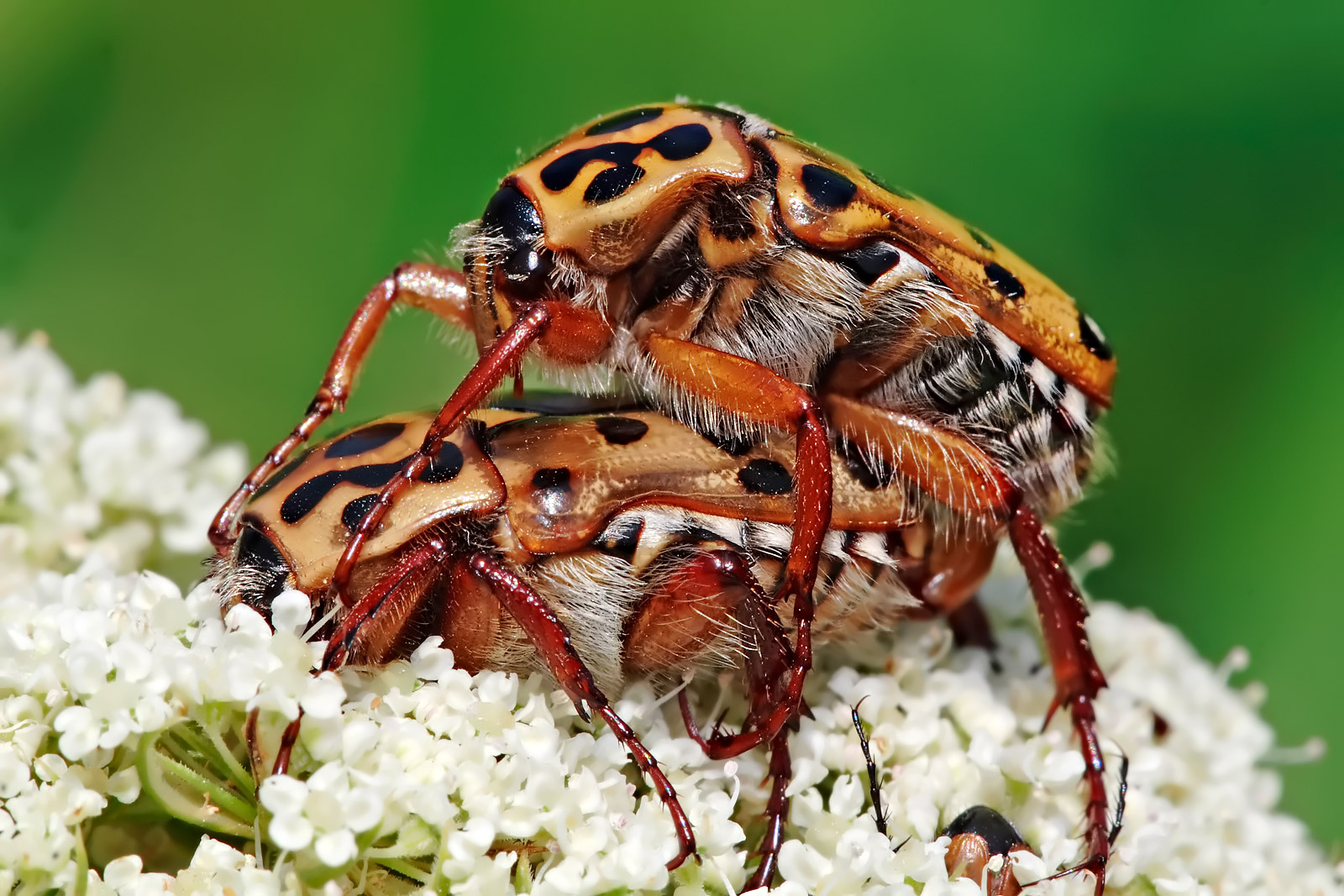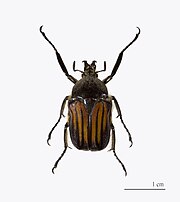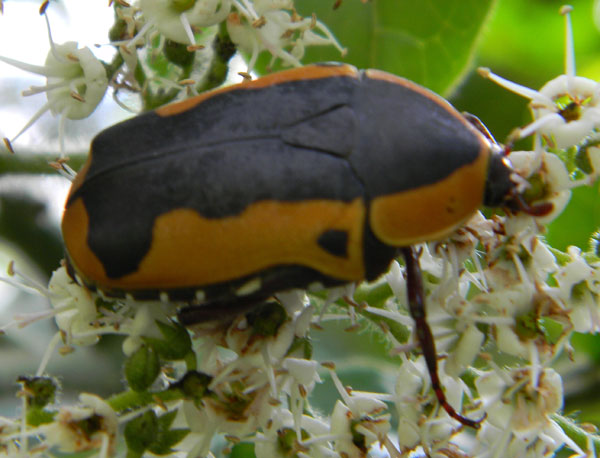Flower chafer
Gold Shiny rose chafer ( Cetonia aurata )
The rose chafer ( Cetoniinae ) are a subfamily of the scarab beetles (Scarabaeidae ). The subfamily is distributed worldwide, but has its main range in the tropics. There are about 3,000 known species in about 400 genera. The taxonomy of the group is considered controversial. It is considered by some authors as a separate family within the Scarabaeoidea, however, Bags & Leschen (2005) do not follow this opinion, but make it as a family to the scarab beetles. In many species, the imagos are lively and / or colored metallic luster. You can, unusually for beetles, develop their second pair of wings to fly through an arch under the closed elytra. The adults feed on emerging liquids, such as plant sap from wounds of trees. The larvae develop in detritus and have the typical for the superfamily form of grubs.
- 5.1 Notes and references
- 5.2 Literature
Features
Beetle
The Rose beetles, for example, with the Goliath beetles ( Goliathus ) are among the biggest but also the most colorful species of Scarabaeoidea. They have a body length of 8 to 110 millimeters and have a slightly to strongly flattened body shape. They are matte brown and black shades to lively, brilliant, often colored with metallic or enamel-like colors in intricate patterns. The compound eyes are separated by a long, narrow canthus. The ommatidia are fully developed ( eucon ). Viewed from above, one can recognize the steering sensing means on the side of the end plate ( Clypeus ). The sensors are zehngliedrig and have a tripartite sensor lobe which carries a specialized sensory apparatus. The mandibles are poorly developed and hidden from the faceplate. The wing covers ( elytra ) are post- humeral clearly indented. The Mesepimeron is prominent and is usually viewed from above at the base of the wing covers to detect. The spiracles on the mesothorax are modified, the Intersegmentalia are much reduced form. The hips ( coxae ) of the front legs are tapered down. A Empodium is available. The apex of the rails ( tibiae ) of the middle leg carries two adjacent spurs, which are separated only by the basal segment of the metatarsals. The Tarsalklauen are simple and vary in size. The position of the spiracles on the abdomen varies, at first they are functional to the seventh abdominal segment. The pygidium is exposed. The Propygidium is rigidly connected usually with the fifth visible sternite.
Larvae
The Galea and lacinia are fused to Mala. The mandibles have a ventral Stridulationsbereich. The body shape of larvae is generally C-shaped, only if they are at fault move on the back straight out. In some genera simple eyes are formed ( ocelli ). The Tormae of the nasopharynx are not adherent and asymmetric.
Way of life
The adults feed almost exclusively by the licking of fluids, such as in wounds of trees or on fruits and nectar. There are, however, within the Cremastocheilini species that feed on the brood and food reserves of social insects. It has been demonstrated a number of species in manure and in termite nests. Most species are diurnal. Uniquely the flight of adult beetles, while the elytra are not open, but the second, underlying pair of wings ( alae ) is deployed by a bulge behind the shoulder.
The larvae usually live freely in detritus, but there are some species that have specialized in doing. They eat these in Ameisenbauten, or nests of birds of prey. If you disturb the larvae, they roll over on his back and move in worm - like pulsating movements. Stiff Dorsalborsten give them during their movement stop.
Taxonomy and systematics
The rose beetles are considered by some authors as a separate family within the Scarabaeoidea, Bags & Leschen (2005) start from the rank of a subfamily that does not include the Valginae, which is considered as a separate subfamily within the scarab beetles (Scarabaeidae ). There she belongs to the clade of phytophagous insects. Phylogenetic relationships within the rose chafer are still unclear and controversial. For example, the position of the Valginae and Trichiinae either as an independent subfamilies or tribes within the rose chafer is unclear.
The rose beetles are divided according to this view, which is directed with the exception of the ranks of Untertaxa essentially according to a classification of Krikken from 1984 into two tribes with a total of 15 subtribe:
- Tribus Trichiini Subtribe Cryptodontina (2 genera; Afrotropical )
- Subtribe Incaina (3 genera; Neotropics )
- Subtribe Osmodermina (1 Holarctic genus, 1 species orientalis)
- Subtribe Platygeniina (1 genus, Afrotropical )
- Subtribe Trichiina (more than 30 genera; New World, Afrotropical, Oriental )
- Subtribe Cremastocheilina ( about 50 genera, mainly Afrotropical, Nearctic and Neotropical well )
- Subtribe Xiphoscelidina ( about 15 genera and nearly exclusively Afrotropical )
- Subtribe Stenotarsiina ( about 50 genera; Madagascar)
- Subtribe Schizorhinina (more than 40 species, almost exclusively Australia and Tasmania, but also orientalis)
- Subtribe Goliathina ( about 80 genera; Afrotropical, Oriental, Nearctic )
- Subtribe Cetoniina (especially Oriental and Afrotropical, Palearctic and Nearctic but also )
- Subtribe Gymnetina ( about 30 genera, mainly Neotropical )
- Subtribe Diplognathina ( about 20 genera, mainly Afrotropical )
- Subtribe Phaedimina (5 genera; orientalis)
- Subtribe Taenioderina (more than 30 genera; orientalis)
Types (selection)
- Shiny gold rose chafer ( Cetonia aurata )
- Mourning Rose Beetle ( Oxythyrea funesta )
- Big rose beetle ( Protaetia aeruginosa)
- Or hermit hermit ( eremita Osmoderma )
- Green precious scratching beetle ( Gnorimus nobilis)
- Bee Beetle ( Trichius fasciatus )
- Stumbling beetle ( Valgus hemipterus )










